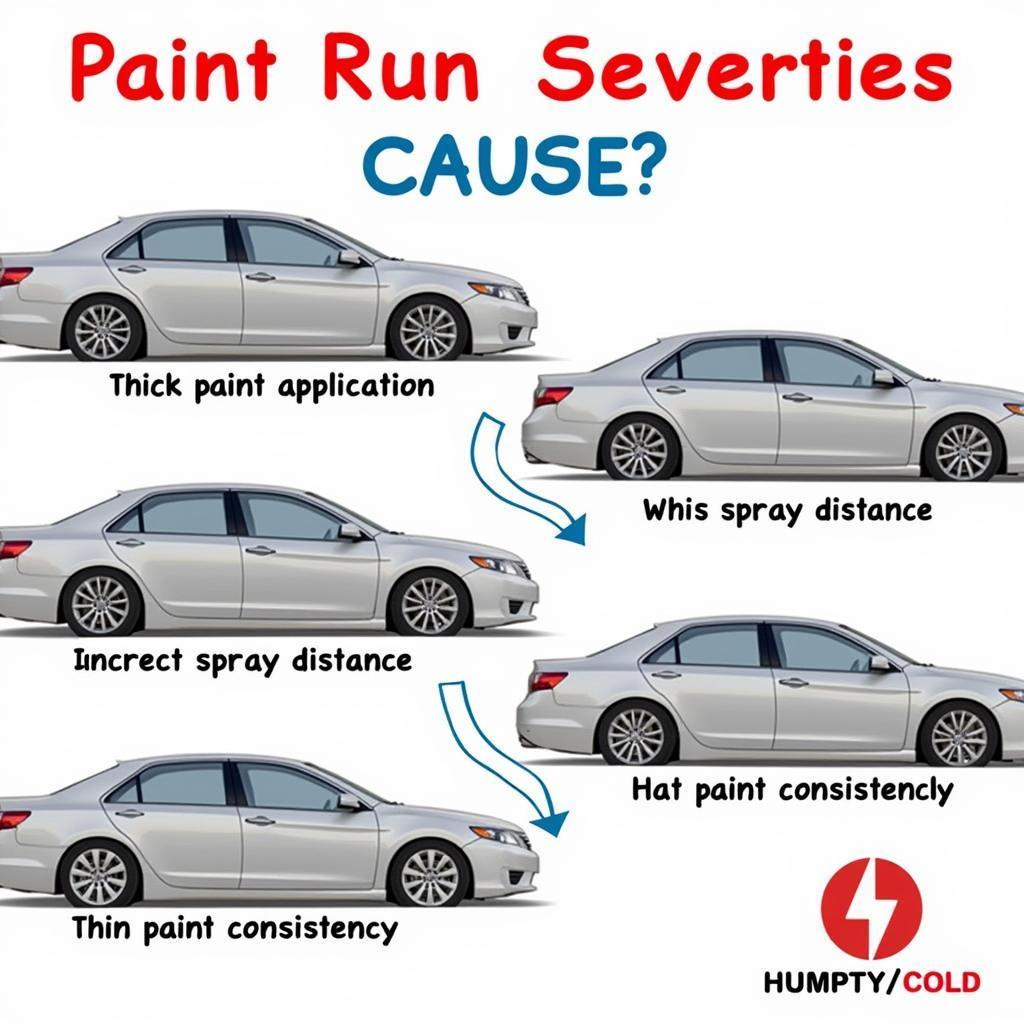Paint runs, those unsightly drips and sags, are a common frustration for anyone who’s attempted DIY car painting. Fortunately, fixing paint runs isn’t as daunting as it might seem. With a little patience and the right techniques, you can achieve a smooth, professional-looking finish. This guide will walk you through how to repair paint runs on cars, from identifying the cause to achieving a flawless result.
Fixing paint runs involves a few key steps, but the first step is determining the severity of the run. Minor imperfections might only require light sanding and polishing, while more significant runs may need a more involved approach. After only a short time learning these techniques, you will understand how to repair paint runs on cars and restore your car’s finish. Let’s dive into the details.
Identifying the Cause of Paint Runs
Before you start repairing paint runs, it’s crucial to understand what caused them in the first place. Common culprits include applying too much paint in one coat, spraying too close to the surface, using paint that’s too thin, or painting in humid or cold conditions. Identifying the cause can help you prevent runs in future painting projects. Understanding the root cause is the first step in successfully mastering how to repair paint runs on cars.
Gathering Your Supplies for Paint Run Repair
Having the right tools and materials on hand will make the repair process smoother and more efficient. You’ll need sandpaper (ranging from 1500 to 2500 grit), rubbing compound, polishing compound, a sanding block, microfiber cloths, masking tape, and if necessary, touch-up paint. Having a well-ventilated work area is also important. Proper preparation is essential for any car painting endeavor, particularly when learning how to repair paint runs on cars.
Sanding Down the Paint Run
Once the paint is completely dry, start by lightly sanding the affected area with 1500-grit sandpaper. Use a sanding block to ensure even pressure and avoid creating flat spots. The goal is to level the run with the surrounding paint without removing too much paint. Gradually move to finer grits (2000 and then 2500) to further refine the surface and prepare it for polishing. For smaller jobs, you may even consider a car scratch repair remover pen paint applicator.
Polishing and Finishing
After sanding, the area will likely appear dull. This is where polishing comes in. Apply a small amount of rubbing compound to a microfiber cloth and work it into the sanded area using circular motions. Follow up with polishing compound to restore the paint’s shine and blend the repaired area seamlessly with the surrounding paint. If you’re working on a specific car color, like grey, check out guides on grey car paint repair for specific tips and tricks.
Touch-Up Paint (If Necessary)
If the paint run was significant and sanding removed some of the base coat, you may need to apply touch-up paint. Use a fine-tipped brush or a spray can (for larger areas) to carefully apply the paint to the affected area. Allow the touch-up paint to dry completely before sanding and polishing it to match the surrounding finish. If you’re dealing with a cracked area, you might find some helpful advice in a guide on paint crack car repair. For those interested in repairing paint on model cars, you might want to know what kind of paint to repair hot wheels cars.
Conclusion
Repairing paint runs on your car is a manageable task with the right knowledge and techniques. By following the steps outlined above, you can restore your car’s finish to its former glory and avoid the cost of professional repairs. Remember patience and attention to detail are key to achieving a flawless result. Understanding how to repair paint runs on cars empowers you to maintain your vehicle’s appearance with confidence. If you’re comfortable with DIY car maintenance, you might even consider learning about spray paint repair car techniques.
FAQ
- What causes paint runs? Applying too much paint, spraying too close, thin paint, or unsuitable weather.
- What grit sandpaper should I use? Start with 1500-grit and gradually move to finer grits (2000 and 2500).
- Do I always need touch-up paint? Only if sanding removes the base coat.
- Can I prevent paint runs? Yes, by applying thin coats, maintaining the correct spray distance, and ensuring appropriate weather conditions.
- What if I’m unsure about the process? Consult a professional for assistance.
Common Scenarios and Questions
- Scenario: My clear coat has a run. Solution: Follow the same sanding and polishing process.
- Question: Can I use a razor blade to remove the run? Answer: Not recommended, as it can scratch the surrounding paint.
Further Exploration
Check out our other articles on car scratch repair remover pen paint applicator and grey car paint repair for more car paint repair tips. We also have a comprehensive guide on what kind of paint to repair hot wheels cars for those interested in model car repair. If you’re looking to explore more comprehensive car painting techniques, our article on spray paint repair car is a valuable resource. Finally, if you’re dealing with cracked paint, our guide on paint crack car repair offers step-by-step solutions.
Need more help? Contact us via WhatsApp: +1(641)206-8880 or email: [email protected]. Our customer support team is available 24/7.



